Chemistry 12
- Unit 1 The Solid State-Deleted
- Unit 2 Solutions
- Unit 3 Electrochemistry
- Unit 4 Chemical Kinetics
- Unit 5 Surface Chemistry-Deleted
- Unit 6 General Principles And Processes Of Isolation Of Elements-Deleted
- Unit 7 The P Block Elements
- Unit 8 The D And F Block Elements
- Unit 9 Coordination Compounds
- Unit 10 Haloalkanes And Haloarenes
- Unit 11 Alcohols, Phenols And Ethers
- Unit 12 Aldehydes, Ketones And Carboxylic Acids
- Unit 13 Amines
- Unit 14 Biomolecules
- Unit 15 Polymers-Deleted
- Unit 16 Chemistry In Everyday Life-Delelted
Unit 11 Alcohols, Phenols And Ethers
You have learnt that substitution of one or more hydrogen atom(s) from a hydrocarbon by another atom or a group of atoms result in the formation of an entirely new compound having altogether different properties and applications. Alcohols and phenols are formed when a hydrogen atom in a hydrocarbon, aliphatic and aromatic respectively, is replaced by
An alcohol contains one or more hydroxyl
The substitution of a hydrogen atom in a hydrocarbon by an alkoxy or aryloxy group (R-O/Ar-O) yields another class of compounds known as ’ethers’, for example,
11.1 Classification
The classification of compounds makes their study systematic and hence simpler. Therefore, let us first learn how are alcohols, phenols and ethers classified?
11.1.1 Alcohols— Mono, Di, Tri or Polyhydric alcohols
Alcohols and phenols may be classified as mono–, di–, tri- or polyhydric compounds depending on whether they contain one, two, three or many hydroxyl groups respectively in their structures as given below:
Monohydric alcohols may be further classified according to the hybridisation of the carbon atom to which the hydroxyl group is attached.
(i) Compounds containing
Primary, secondary and tertiary alcohols: In these three types of alcohols, the
Allylic alcohols: In these alcohols, the -
Benzylic alcohols: In these alcohols, the
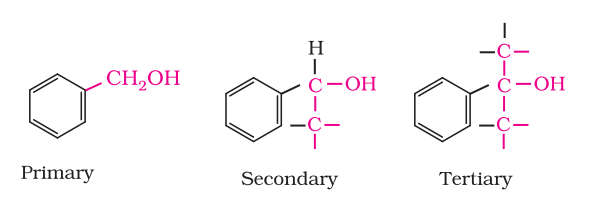
Allylic and benzylic alcohols may be primary, secondary or tertiary.
(ii) Compounds containing
Vinylic alcohol:
Intext Questions
11.1 Classify the following as primary, secondary and tertiary alcohols:
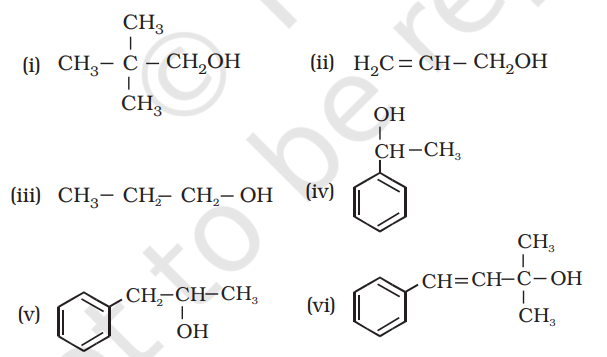
Answer
Primary alcohol
Secondary alcohol
Tertiary alcohol
11.2 Identify allylic alcohols in the above exam
Answer
The alcohols given in (ii) and (vi) are allylic alcohols.
11.1.2 Phenols— Mono, Di and trihydric phenols

11.1.3 Ethers
Ethers are classified as simple or symmetrical, if the alkyl or aryl groups attached to the oxygen atom are the same, and mixed or unsymmetrical, if the two groups are different. Diethyl ether,
11.2 Nomenclature
(a) Alcohols: The common name of an alcohol is derived from the common name of the alkyl group and adding the word alcohol to it. For example,
According to IUPAC system, the name of an alcohol is derived from the name of the alkane from which the alcohol is derived, by substituting ’

Cyclic alcohols are named using the prefix cyclo and considering the —OH group attached to C–1.

(b) Phenols: The simplest hydroxy derivative of benzene is phenol. It is its common name and also an accepted IUPAC name. As structure of phenol involves a benzene ring, in its substituted compounds the terms ortho (1,2- disubstituted), meta (1,3-disubstituted) and para (1,4-disubstituted) are often used in the common names.

Dihydroxy derivatives of benzene are known as 1, 2-, 1, 3- and 1, 4-benzenediol.
(c) Ethers: Common names of ethers are derived from the names of alkyl/ aryl groups written as separate words in alphabetical order and adding the word ’ether’ at the end. For example,

If both the alkyl groups are the same, the prefix ‘di’ is added before the alkyl group. For example,
According to IUPAC system of nomenclature, ethers are regarded as hydrocarbon derivatives in which a hydrogen atom is replaced by an -OR or -OAr group, where
Example 11.1
Give IUPAC names of the following compounds:

Solution
(i) 4-Chloro-2,3-dimethylpentan-1-ol
(ii) 2-Ethoxypropane
(iii) 2,6-Dimethylphenol
(iv) 1-Ethoxy-2-nitrocyclohexane
Intext Question
11.3 Name the following compounds according to IUPAC system.

Answer
(i) 3-Chloromethyl-2-isopropylpentan-1-ol
(ii) 2, 5-Dimethylhexane-1, 3-diol
(iii) 3-Bromocyclohexanol
(iv) Hex-1-en-3-ol
(v) 2-Bromo-3-methylbut-2-en-1-ol
11.3 Structures of Functional Groups
In alcohols, the oxygen of the

The bond angle
(i) partial double bond character on account of the conjugation of unshared electron pair of oxygen with the aromatic ring (Section 7.4.4) and
(ii)
In ethers, the four electron pairs, i.e., the two bond pairs and two lone pairs of electrons on oxygen are arranged approximately in a tetrahedral arrangement. The bond angle is slightly greater than the tetrahedral angle due to the repulsive interaction between the two bulky (-R) groups. The
11.4 Alcohols and Phenols
11.4.1 Preparation of Alcohols
Alcohols are prepared by the following methods:
1. From alkenes
(i) By acid catalysed hydration: Alkenes react with water in the presence of acid as catalyst to form alcohols. In case of unsymmetrical alkenes, the addition reaction takes place in accordance with Markovnikov’s rule (Unit 13, Class XI).
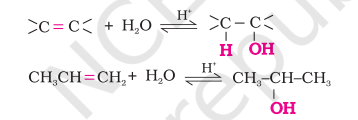
Mechanism
The mechanism of the reaction involves the following three steps:
Step 1: Protonation of alkene to form carbocation by electrophilic attack of

Step 2: Nucleophilic attack of water on carbocation

Step 3: Deprotonation to form an alcohol.

(ii) By hydroboration-oxidation: Diborane
The addition of borane to the double bond takes place in such a manner that the boron atom gets attached to the sp2 carbon carrying greater number of hydrogen atoms. The alcohol so formed looks as if it has been formed by the addition of water to the alkene in a way opposite to the Markovnikov’s rule. In this reaction, alcohol is obtained in excellent yield.
2. From carbonyl compounds
(i) By reduction of aldehydes and ketones: Aldehydes and ketones are reduced to the corresponding alcohols by addition of hydrogen in the presence of catalysts (catalytic hydrogenation). The usual catalyst is a finely divided metal such as platinum, palladium or nickel. It is also prepared by treating aldehydes and ketones with sodium borohydride
(ii) By reduction of carboxylic acids and esters: Carboxylic acids are reduced to primary alcohols in excellent yields by lithium aluminium hydride, a strong reducing agent.
However,
3. From Grignard reagents
Alcohols are produced by the reaction of Grignard reagents (Unit 10, Class XII) with aldehydes and ketones.

The first step of the reaction is the nucleophilic addition of Grignard reagent to the carbonyl group to form an adduct. Hydrolysis of the adduct yields an alcohol.
The overall reactions using different aldehydes and ketones are as follows:
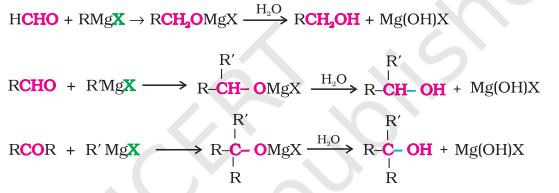
You will notice that the reaction produces a primary alcohol with methanal, a secondary alcohol with other aldehydes and tertiary alcohol with ketones.
Example 11.2 Give the structures and IUPAC names of the products expected from the following reactions:
(a) Catalytic reduction of butanal.
(b) Hydration of propene in the presence of dilute sulphuric acid.
(c) Reaction of propanone with methylmagnesium bromide followed by hydrolysis.
Solution

11.4.2 Preparation of Phenols
Phenol, also known as carbolic acid, was first isolated in the early nineteenth century from coal tar. Nowadays, phenol is commercially produced synthetically. In the laboratory, phenols are prepared from benzene derivatives by any of the following methods:
1. From haloarenes Chlorobenzene is fused with

2. From benzenesulphonic acid Benzene is sulphonated with oleum and benzene sulphonic acid so formed is converted to sodium phenoxide on heating with molten sodium hydroxide. Acidification of the sodium salt gives phenol.

3. From diazonium salts A diazonium salt is formed by treating an aromatic primary amine with nitrous acid
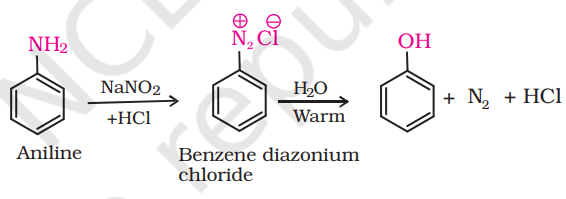
4. From cumene Phenol is manufactured from the hydrocarbon, cumene. Cumene (isopropylbenzene) is oxidised in the presence of air to cumene hydroperoxide. It is converted to phenol and acetone by treating it with dilute acid. Acetone, a by-product of this reaction, is also obtained in large quantities by this method.
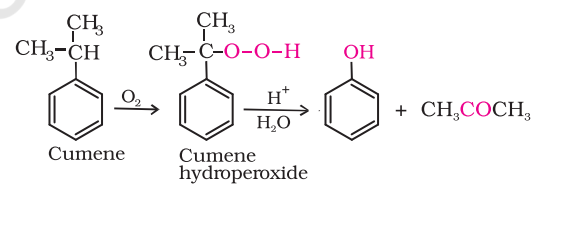
Intext Questions
11.4 Show how are the following alcohols prepared by the reaction of a suitable Grignard reagent on methanal?

Answer
(i)

(ii)

11.5 Write structures of the products of the following reactions:
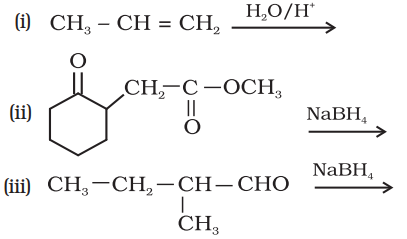
Answer

11.4.3 Physical Properties
Alcohols and phenols consist of two parts, an alkyl/aryl group and a hydroxyl group. The properties of alcohols and phenols are chiefly due to the hydroxyl group. The nature of alkyl and aryl groups simply modify these properties.
Boiling Points
The boiling points of alcohols and phenols increase with increase in the number of carbon atoms (increase in van der Waals forces). In alcohols, the boiling points decrease with increase of branching in carbon chain (because of decrease in van der Waals forces with decrease in surface area).
The –OH group in alcohols and phenols is involved in intermolecular hydrogen bonding as shown below:
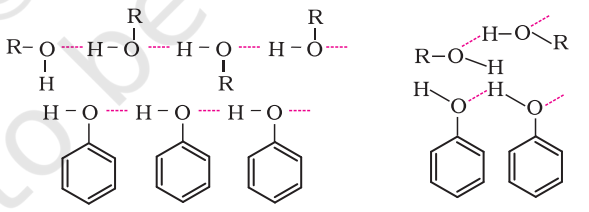
It is interesting to note that boiling points of alcohols and phenols are higher in comparison to other classes of compounds, namely hydrocarbons, ethers, haloalkanes and haloarenes of comparable molecular masses. For example, ethanol and propane have comparable molecular masses but their boiling points differ widely. The boiling point of methoxymethane is intermediate of the two boiling points.

The high boiling points of alcohols are mainly due to the presence of intermolecular hydrogen bonding in them which is lacking in ethers and hydrocarbons.
Solubility
Solubility of alcohols and phenols in water is due to their ability to form hydrogen bonds with water molecules as shown. The solubility decreases with increase in size of alkyl/aryl (hydrophobic) groups. Several of the lower molecular mass alcohols are miscible with water in all proportions.
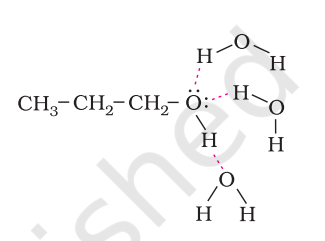
Example 11.3 Arrange the following sets of compounds in order of their increasing boiling points:
(a) Pentan-1-ol, butan-1-ol, butan-2-ol, ethanol, propan-1-ol, methanol.
(b) Pentan-1-ol, n-butane, pentanal, ethoxyethane.
Solution
(a) Methanol, ethanol, propan-1-ol, butan-2-ol, butan-1-ol, pentan-1-ol.
(b) n-Butane, ethoxyethane, pentanal and pentan-1-ol.
11.4.4 Chemical Reactions
Alcohols are versatile compounds. They react both as nucleophiles and electrophiles. The bond between
(i) 
(ii) The bond between

Protonated alcohols as electrophiles
Based on the cleavage of
(a) Reactions involving cleavage of O–H bond
1. Acidity of alcohols and phenols
(i) Reaction with metals: Alcohols and phenols react with active metals such as sodium, potassium and aluminium to yield corresponding alkoxides/phenoxides and hydrogen.
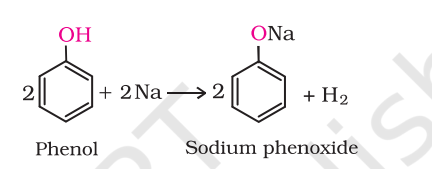
In addition to this, phenols react with aqueous sodium hydroxide to form sodium phenoxides.
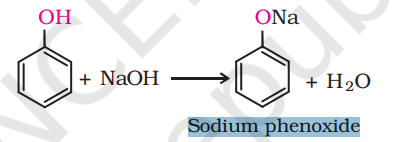
The above reactions show that alcohols and phenols are acidic in nature. In fact, alcohols and phenols are Brönsted acids i.e., they can donate a proton to a stronger base (B:).
(ii) Acidity of alcohols: The acidic character of alcohols is due to the polar nature of
Alcohols are, however, weaker acids than water. This can be illustrated by the reaction of water with an alkoxide.
This reaction shows that water is a better proton donor (i.e., stronger acid) than alcohol. Also, in the above reaction, we note that an alkoxide ion is a better proton acceptor than hydroxide ion, which suggests that alkoxides are stronger bases (sodium ethoxide is a stronger base than sodium hydroxide).
Alcohols act as Bronsted bases as well. It is due to the presence of unshared electron pairs on oxygen, which makes them proton acceptors.
(iii) Acidity of phenols: Acidity of phenols: The reactions of phenol with metals (e.g., sodium, aluminium) and sodium hydroxide indicate its acidic nature. The hydroxyl group, in phenol is directly attached to the

The reaction of phenol with aqueous sodium hydroxide indicates that phenols are stronger acids than alcohols and water. Let us examine how a compound in which hydroxyl group attached to an aromatic ring is more acidic than the one in which hydroxyl group is attached to an alkyl group.
The ionisation of an alcohol and a phenol takes place as follows:
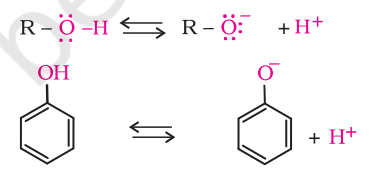
Due to the higher electronegativity of

In substituted phenols, the presence of electron withdrawing groups such as nitro group, enhances the acidic strength of phenol. This effect is more pronounced when such a group is present at ortho and para positions. It is due to the effective delocalisation of negative charge in phenoxide ion when substituent is at ortho or para position. On the other hand, electron releasing groups, such as alkyl groups, in general, do not favour the formation of phenoxide ion resulting in decrease in acid strength. Cresols, for example, are less acidic than phenol.

2. Esterification
Alcohols and phenols react with carboxylic acids, acid chlorides and acid anhydrides to form esters.
Aspirin possesses analgesic, antiinflammatory and antipyretic properties.
The reaction with carboxylic acid and acid anhydride is carried out in the presence of a small amount of concentrated sulphuric acid. The reaction is reversible, and therefore, water is removed as soon as it is formed. The reaction with acid chloride is carried out in the presence of a base (pyridine) so as to neutralise

(b) Reactions involving cleavage of carbon - oxygen (C–O) bond in alcohols
The reactions involving cleavage of carbon - oxygen (
1. Reaction with hydrogen halides: Alcohols react with hydrogen halides to form alkyl halides (Refer Unit 6, Class XII).
2. Reaction with phosphorus trihalides: Alcohols are converted to alkyl bromides by reaction with phosphorus tribromide (Refer Unit 10, Class XII).
3. Dehydration: Alcohols undergo dehydration (removal of a molecule of water) to form alkenes on treating with a protic acid e.g., concentrated
Ethanol undergoes dehydration by heating it with concentrated
Secondary and tertiary alcohols are dehydrated under milder conditions. For example
Thus, the relative ease of dehydration of alcohols follows the following order: Tertiary > Secondary > Primary The mechanism of dehydration of ethanol involves the following steps:
Mechanism
Step 1: Formation of protonated alcohol.
Step 2: Formation of carbocation: It is the slowest step and hence, the rate determining step of the reaction.
Step 3: Formation of ethene by elimination of a proton.
The acid used in step 1 is released in step 3. To drive the equilibrium to the right, ethene is removed as it is formed.
4. Oxidation: Oxidation of alcohols involves the formation of a carbonoxygen double bond with cleavage of an
Such a cleavage and formation of bonds occur in oxidation reactions. These are also known as dehydrogenation reactions as these involve loss of dihydrogen from an alcohol molecule. Depending on the oxidising agent used, a primary alcohol is oxidised to an aldehyde which in turn is oxidised to a carboxylic acid.
Strong oxidising agents such as acidified potassium permanganate are used for getting carboxylic acids from alcohols directly.
A better reagent for oxidation of primary alcohols to aldehydes in good yield is pyridinium chlorochromate (PCC), a complex of chromium trioxide with pyridine and
Secondary alcohols are oxidised to ketones by chromic anhyride
Tertiary alcohols do not undergo oxidation reaction. Under strong reaction conditions such as strong oxidising agents
When the vapours of a primary or a secondary alcohol are passed over heated copper at
(c) Reactions of phenols Following reactions are shown by phenols only.
1. Electrophilic aromatic substitution In phenols, the reactions that take place on the aromatic ring are electrophilic substitution reactions (Unit 9, Class XI). The -OH group attached to the benzene ring activates it towards electrophilic substitution. Also, it directs the incoming group to ortho and para positions in the ring as these positions become electron rich due to the resonance effect caused by
Common electrophilic aromatic substitution reactions taking place in phenol are as follows:
(i) Nitration: With dilute nitric acid at low temperature (298 K), phenol yields a mixture of ortho and para nitrophenols.

The ortho and para isomers can be separated by steam distillation. o-Nitrophenol is steam volatile due to intramolecular hydrogen bonding while p-nitrophenol is less volatile due to intermolecular hydrogen bonding which causes the association of molecules.

With concentrated nitric acid, phenol is converted to 2,4,6-trinitrophenol. The product is commonly known as picric acid. The yield of the reaction product is poor.
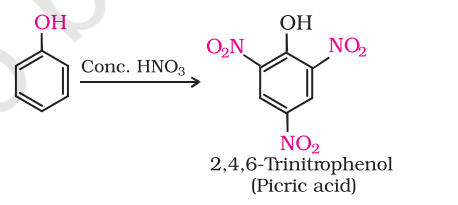
Nowadays picric acid is prepared by treating phenol first with concentrated sulphuric acid which converts it to phenol-2,4-disulphonic acid, and then with concentrated nitric acid to get 2,4,6-trinitrophenol. Can you write the equations of the reactions involved?
(ii) Halogenation: On treating phenol with bromine, different reaction products are formed under different experimental conditions.
(a) When the reaction is carried out in solvents of low polarity such as
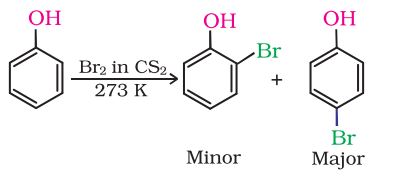
The usual halogenation of benzene takes place in the presence of a Lewis acid, such as
(b) When phenol is treated with bromine water,
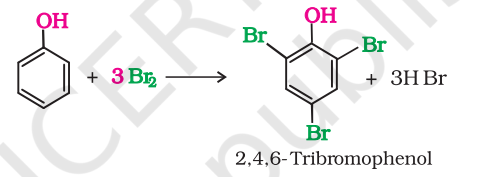
Example 11.5
Write the structures of the major products expected from the following reactions:
(a) Mononitration of 3-methylphenol
(b) Dinitration of 3-methylphenol
(c) Mononitration of phenyl methanoate.
Solution The combined influence of

2. Kolbe’s reaction
Phenoxide ion generated by treating phenol with sodium hydroxide is even more reactive than phenol towards electrophilic aromatic substitution. Hence, it undergoes electrophilic substitution with carbon dioxide, a weak electrophile. Ortho hydroxybenzoic acid is formed as the main reaction product.

3. Reimer-Tiemann reaction
On treating phenol with chloroform in the presence of sodium hydroxide, a –CHO group is introduced at ortho position of benzene ring. This reaction is known as Reimer - Tiemann reaction.
The intermediate substituted benzal chloride is hydrolysed in the presence of alkali to produce salicylaldehyde.

4. Reaction of phenol with zinc dust
Phenol is converted to benzene on heating with zinc dust.

5. Oxidation
Oxidation of phenol with chromic acid produces a conjugated diketone known as benzoquinone. In the presence of air, phenols are slowly oxidised to dark coloured mixtures containing quinones.
Intext Questions
11.6 Give structures of the products you would expect when each of the following alcohol reacts with (a)
(i) Butan-1-ol
(ii) 2-Methylbutan-2-ol
Answer
(a)
(i)
Primary alcohols do not react appreciably with Lucas’ reagent
(ii)

Tertiary alcohols react immediately with Lucas’ reagent
(b)
(i)
(ii)

(c)
(i)
(ii)

11.7 Predict the major product of acid catalysed dehydration of
(i) 1-methylcyclohexanol and
(ii) butan-1-ol
Answer
(i)

(ii)
11.8 Ortho and para nitrophenols are more acidic than phenol. Draw the resonance structures of the corresponding phenoxide ions.
Answer

Resonance structure of the phenoxide ion

Resonance structures of

Resonance structures of o-nitrophenoxide ion
It can be observed that the presence of nitro groups increases the stability of phenoxide ion.
11.9 Write the equations involved in the following reactions:
(i) Reimer - Tiemann reaction
(ii) Kolbe’s reaction
Answer
i. Reimer-Tiemann reaction

ii. Kolbe’s reaction

11.5 Some Commercially Important Alcohols
Methanol and ethanol are among the two commercially important alcohols.
1. Methanol
Methanol,
Methanol is a colourless liquid and boils at 337 K. It is highly poisonous in nature. Ingestion of even small quantities of methanol can cause blindness and large quantities causes even death. Methanol is used as a solvent in paints, varnishes and chiefly for making formaldehyde.
2. Ethanol
Ethanol,
In wine making, grapes are the source of sugars and yeast. As grapes ripen, the quantity of sugar increases and yeast grows on the outer skin. When grapes are crushed, sugar and the enzyme come in contact and fermentation starts. Fermentation takes place in anaerobic conditions i.e. in absence of air. Carbon dioxide is released during fermentation.
The action of zymase is inhibited once the percentage of alcohol formed exceeds 14 percent. If air gets into fermentation mixture, the oxygen of air oxidises ethanol to ethanoic acid which in turn destroys the taste of alcoholic drinks.
Ethanol is a colourless liquid with boiling point
Nowadays, large quantities of ethanol are obtained by hydration of ethene (Section 11.4).
11.6 Ethers
11.6.1 Preparation of Ethers
1. By dehydration of alcohols
Alcohols undergo dehydration in the presence of protic acids
The formation of ether is a nucleophilic bimolecular reaction
Acidic dehydration of alcohols, to give an alkene is also associated with substitution reaction to give an ether.
The method is suitable for the preparation of ethers having primary alkyl groups only. The alkyl group should be unhindered and the temperature be kept low. Otherwise the reaction favours the formation of alkene. The reaction follows SN1 pathway when the alcohol is secondary or tertiary about which you will learn in higher classes. However, the dehydration of secondary and tertiary alcohols to give corresponding ethers is unsuccessful as elimination competes over substitution and as a consequence, alkenes are easily formed.
Can you explain why is bimolecular dehydration not appropriate for the preparation of ethyl methyl ether?
2. Williamson synthesis
It is an important laboratory method for the preparation of symmetrical and unsymmetrical ethers. In this method, an alkyl halide is allowed to react with sodium alkoxide.
Ethers containing substituted alkyl groups (secondary or tertiary) may also be prepared by this method. The reaction involves SN2 attack of an alkoxide ion on primary alkyl halide.
Better results are obtained if the alkyl halide is primary. In case of secondary and tertiary alkyl halides, elimination competes over substitution. If a tertiary alkyl halide is used, an alkene is the only reaction product and no ether is formed. For example, the reaction of CH3ONa with (CH3)3C–Br gives exclusively 2-methylpropene.
It is because alkoxides are not only nucleophiles but strong bases as well. They react with alkyl halides leading to elimination reactions.
Example 11.6 The following is not an appropriate reaction for the preparation of t-butyl ethyl ether
(i) What would be the major product of this reaction?
(ii) Write a suitable reaction for the preparation of t-butylethyl ether.
Solution (i) The major product of the given reaction is 2-methylprop-1-ene. It is because sodium ethoxide is a strong nucleophile as well as a strong base. Thus elimination reaction predominates over substitution.

Phenols are also converted to ethers by this method. In this, phenol is used as the phenoxide moiety.

11.6.2 Physical Properties
The
| Formula | Ethoxyethane |
Butan-1-ol |
|
|---|---|---|---|
| b.p./K | 309.1 | 307.6 | 390 |
The large difference in boiling points of alcohols and ethers is due to the presence of hydrogen bonding in alcohols.
The miscibility of ethers with water resembles those of alcohols of the same molecular mass. Both ethoxyethane and butan-1-ol are miscible to almost the same extent i.e., 7.5 and
11.6.3 Chemical Reactions
1. Cleavage of C–O bond in ethers
Ethers are the least reactive of the functional groups. The cleavage of
Ethers with two different alkyl groups are also cleaved in the same manner.

Ethers with two different alkyl groups are also cleaved in the same manner.
The order of reactivity of hydrogen halides is as follows:
However, when one of the alkyl group is a tertiary group, the halide formed is a tertiary halide.
It is because in step 2 of the reaction, the departure of leaving group (HO–CH3) creates a more stable carbocation [(CH3)3C+], and the reaction follows SN1 mechanism.
In case of anisole, methylphenyl oxonium ion,
Therefore the attack by I’ ion breaks
2. Electrophilic substitution The alkoxy group (-OR) is ortho, para directing and activates the aromatic ring towards electrophilic substitution in the same way as in phenol.

(i) Halogenation: Phenylalkyl ethers undergo usual halogenation in the benzene ring, e.g., anisole undergoes bromination with bromine in ethanoic acid even in the absence of iron (III) bromide catalyst. It is due to the activation of benzene ring by the methoxy group. Para isomer is obtained in 90% yield.
(ii) Friedel-Crafts reaction: Anisole undergoes Friedel-Crafts reaction, i.e., the alkyl and acyl groups are introduced at ortho and para positions by reaction with alkyl halide and acyl halide in the presence of anhydrous aluminium chloride (a Lewis acid) as catalyst.
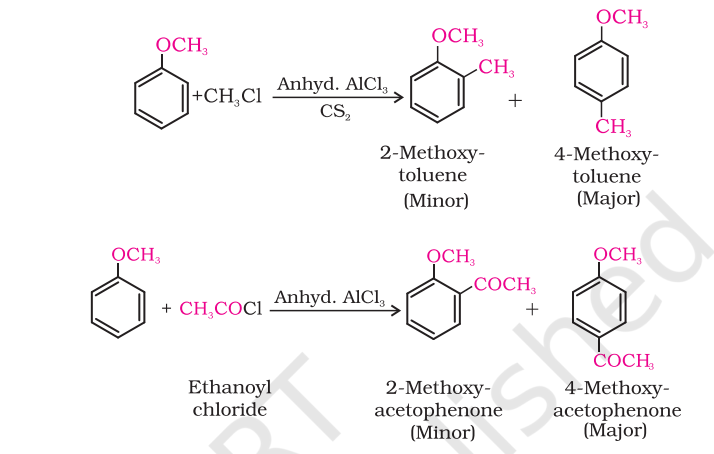
(iii) Nitration: Anisole reacts with a mixture of concentrated sulphuric and nitric acids to yield a mixture of ortho and para nitroanisole.
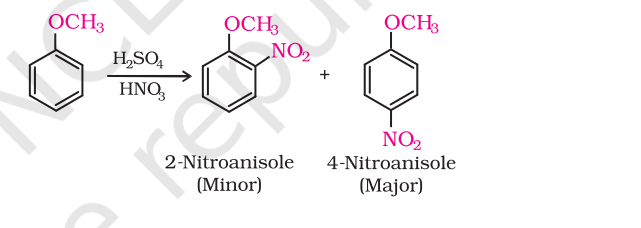
Intext Questions
11.10 Write the reactions of Williamson synthesis of 2-ethoxy-3-methylpentane starting from ethanol and 3-methylpentan-2-ol.
Answer
In Williamson synthesis, an alkyl halide reacts with an alkoxide ion. Also, it is an

11.11 Which of the following is an appropriate set of reactants for the preparation of 1-methoxy-4-nitrobenzene and why?

Answer
Set (ii) is an appropriate set of reactants for the preparation of 1-methoxy-4-nitrobenzene.

1-Methoxy - 4- nitrobenzene
In set (i), sodium methoxide
11.12 Predict the products of the following reactions:
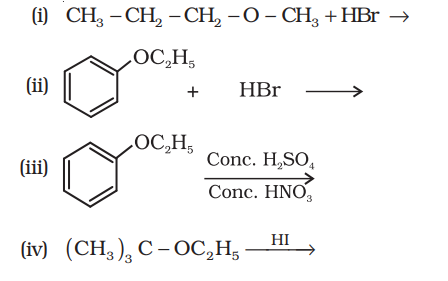
Answer
(i)
(ii)

(iii)

(iv)
Summary
Alcohols and phenols are classified (i) on the basis of the number of hydroxyl groups and (ii) according to the hybridisation of the carbon atom,
Alcohols may be prepared (1) by hydration of alkenes (i) in presence of an acid and (ii) by hydroboration-oxidation reaction (2) from carbonyl compounds by (i) catalytic reduction and (ii) the action of Grignard reagents. Phenols may be prepared by (1) substitution of (i) halogen atom in haloarenes and (ii) sulphonic acid group in aryl sulphonic acids, by
Alcohols are higher boiling than other classes of compounds, namely hydrocarbons, ethers and haloalkanes of comparable molecular masses. The ability of alcohols, phenols and ethers to form intermolecular hydrogen bonding with water makes them soluble in it.
Alcohols and phenols are acidic in nature. Electron withdrawing groups in phenol increase its acidic strength and electron releasing groups decrease it.
Alcohols undergo nucleophilic substitution with hydrogen halides to yield alkyl halides. Dehydration of alcohols gives alkenes. On oxidation, primary alcohols yield aldehydes with mild oxidising agents and carboxylic acids with strong oxidising agents while secondary alcohols yield ketones. Tertiary alcohols are resistant to oxidation.
The presence of
Ethers may be prepared by (i) dehydration of alcohols and (ii) williamson synthesis. The boiling points of ethers resemble those of alkanes while their solubility is comparable to those of alcohols having same molecular mass. The
Exercises
11.1 Write IUPAC names of the following compounds:
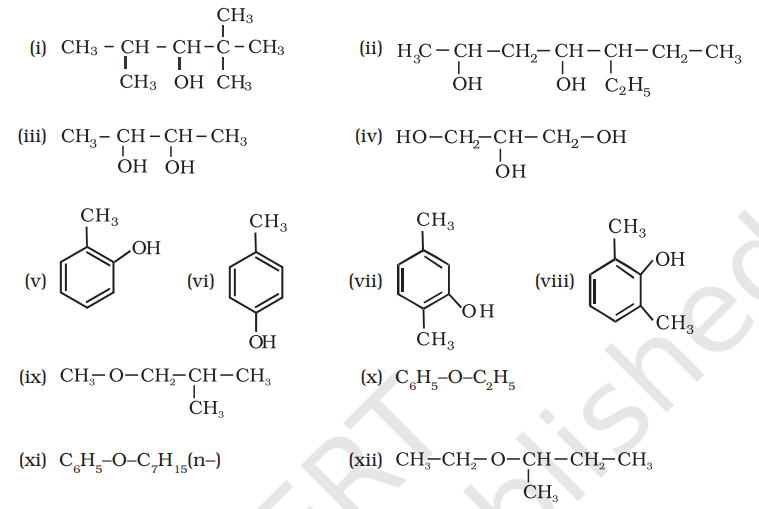
Answer
(i) 2, 2, 4-Trimethylpentan-3-ol
(ii) 5-Ethylheptane-2, 4-diol
(iii) Butane-2, 3-diol
(iv) Propane-1, 2, 3-triol
(v) 2-Methylphenol
(vi) 4-Methylphenol
(vii) 2, 5-Dimethylphenol
(viii) 2, 6-Dimethylphenol
(ix) 1-Methoxy-2-methylpropane
(x) Ethoxybenzene
(xi) 1-Phenoxyheptane
(xii) 2-Ethoxybutane
11.2 Write structures of the compounds whose IUPAC names are as follows:
(i) 2-Methylbutan-2-ol
(ii) 1-Phenylpropan-2-ol
(iii) 3,5-Dimethylhexane -1, 3, 5-triol
(iv) 2,3 - Diethylphenol
(v) 1 - Ethoxypropane
(vi) 2-Ethoxy-3-methylpentane
(vii) Cyclohexylmethanol
(ix) Cyclopent-3-en-1-ol
(viii) 3-Cyclohexylpentan-3-ol
(x) 4-Chloro-3-ethylbutan-1-ol.
Answer
(i)

(ii)

(iii)

(iv)

(v)
(vi)

(vii)

(viii)

(ix)

(x)

11.3 (i) Draw the structures of all isomeric alcohols of molecular formula
(i) as primary, secondary and tertiary alcohols.
(ii) Classify the isomers of alcohols in question 11.3
Answer
(i) The structures of all isomeric alcohols of molecular formula,
(a)
Pentan-1-ol
(b)

2-Methylbutan-1-ol
(c)

3-Methylbutan-1-ol (1)
(d)

2, 2-Dimethylpropan-1-ol
(e)

Pentan-2-ol (2°)
(f)

3-Methylbutan-2-ol (2)
(g)

Pentan-3-ol
(h)

2-Methylbutan-2-ol
(ii) Primary alcohol: Pentan-1-ol; 2-Methylbutan-1-ol;
3-Methylbutan-1-ol; 2, 2 - Dimethylpropan-1-ol
Secondary alcohol: Pentan-2-ol; 3-Methylbutan-2-ol;
Pentan-3-ol
Tertiary alcohol: 2-methylbutan-2-ol
11.4 Explain why propanol has higher boiling point than that of the hydrocarbon, butane?
Answer
Propanol undergoes intermolecular

Therefore, extra energy is required to break hydrogen bonds. For this reason, propanol has a higher boiling point than hydrocarbon butane.
11.5 Alcohols are comparatively more soluble in water than hydrocarbons of comparable molecular masses. Explain this fact.
Answer
Alcohols form

As a result, alcohols are comparatively more soluble in water than hydrocarbons of comparable molecular masses.
11.6 What is meant by hydroboration-oxidation reaction? Illustrate it with an example.
Answer
The addition of borane followed by oxidation is known as the hydroboration-oxidation reaction. For example, propan1-ol is produced by the hydroboration-oxidation reaction of propene. In this reaction, propene reacts with diborane

11.7 Give the structures and IUPAC names of monohydric phenols of molecular formula,
Answer

11.8 While separating a mixture of ortho and para nitrophenols by steam distillation, name the isomer which will be steam volatile. Give reason.
Answer
Intramolecular H-bonding is present in o-nitrophenol. In p-nitrophenol, the molecules are strongly associated due to the presence of intermolecular bonding. Hence, o-nitrophenol is steam volatile.

11.9 Give the equations of reactions for the preparation of phenol from cumene.
Answer
To prepare phenol, cumene is first oxidized in the presence of air of cumene hydro-peroxide.

Then, cumene hydroxide is treated with dilute acid to prepare phenol and acetone as by-products.

11.10 Write chemical reaction for the preparation of phenol from chlorobenzene.
Answer
Chlorobenzene is fused with

11.11 Write the mechanism of hydration of ethene to yield ethanol.
Answer
The mechanism of hydration of ethene to form ethanol involves three steps.
Step 1:
Protonation of ethene to form carbocation by electrophilic attack of

Step 2:
Nucleophilic attack of water on carbocation:

Step 3:
Deprotonation to form ethanol:

11.12 You are given benzene, conc.
Answer

11.13 Show how will you synthesise:
(i) 1-phenylethanol from a suitable alkene.
(ii) cyclohexylmethanol using an alkyl halide by an
(iii) pentan-1-ol using a suitable alkyl halide?
Answer
(i) By acid-catalyzed hydration of ethylbenzene (styrene), 1-phenylethanol can be synthesized.

(ii) When chloromethylcyclohexane is treated with sodium hydroxide, cyclohexylmethanol is obtained.

(iii) When 1-chloropentane is treated with
11.14 Give two reactions that show the acidic nature of phenol. Compare acidity of phenol with that of ethanol.
Answer
The acidic nature of phenol can be represented by the following two reactions:
(i) Phenol reacts with sodium to give sodium phenoxide, liberating

(ii) Phenol reacts with sodium hydroxide to give sodium phenoxide and water as by-products.

The acidity of phenol is more than that of ethanol. This is because after losing a proton, the phenoxide ion undergoes resonance and gets stabilized whereas ethoxide ion does not.

11.15 Explain why is ortho nitrophenol more acidic than ortho methoxyphenol ?
Answer

The nitro-group is an electron-withdrawing group. The presence of this group in the ortho position decreases the electron density in the
On the other hand, methoxy group is an electron-releasing group. Thus, it increases the electron density in the O-H bond and hence, the proton cannot be given out easily.
For this reason, ortho-nitrophenol is more acidic than ortho-methoxyphenol.
11.16 Explain how does the
The -

As a result, the benzene ring is activated towards electrophilic substitution.
11.17 Give equations of the following reactions:
(i) Oxidation of propan-1-ol with alkaline
(ii) Bromine in
(iii) Dilute
(iv) Treating phenol wih chloroform in presence of aqueous
Answer
(i)
(ii)

(iii)

(iv)

11.18 Explain the following with an example.
(i) Kolbe’s reaction.
(ii) Reimer-Tiemann reaction.
(iii) Williamson ether synthesis.
(iv) Unsymmetrical ether.
Answer
(i) Kolbe’s reaction:
When phenol is treated with sodium hydroxide, sodium phenoxide is produced. This sodium phenoxide when treated with carbon dioxide, followed by acidification, undergoes electrophilic substitution to give ortho-hydroxybenzoic acid as the main product. This reaction is known as Kolbe’s reaction.

(ii) Reimer-Tiemann reaction:
When phenol is treated with chloroform

This reaction is known as the Reimer-Tiemann reaction.
The intermediate is hydrolyzed in the presence of alkalis to produce salicyclaldehyde.

(iii) Williamson ether synthesis:
Williamson ether synthesis is a laboratory method to prepare symmetrical and unsymmetrical ethers by allowing alkyl halides to react with sodium alkoxides.
This reaction involves

If the alkyl halide is secondary or tertiary, then elimination competes over substitution.
(iv) Unsymmetrical ether:
An unsymmetrical ether is an ether where two groups on the two sides of an oxygen atom differ (i.e., have an unequal number of carbon atoms). For example: ethyl methyl ether
11.19 Write the mechanism of acid dehydration of ethanol to yield ethene.
Answer
The mechanism of acid dehydration of ethanol to yield ethene involves the following three steps:
Step 1:
Protonation of ethanol to form ethyl oxonium ion:

Step 2:
Formation of carbocation (rate determining step):

Step 3:
Elimination of a proton to form ethene:

The acid consumed in step 1 is released in Step 3. After the formation of ethene, it is removed to shift the equilibrium in a forward direction.
11.20 How are the following conversions carried out?
(i) Propene
(ii) Benzyl chloride
(iii) Ethyl magnesium chloride
(iv) Methyl magnesium bromide
Answer
(i) If propene is allowed to react with water in the presence of an acid as a catalyst, then propan-2-ol is obtained.

(ii) If benzyl chloride is treated with

(iii) When ethyl magnesium chloride is treated with methanal, an adduct is the produced which gives propan-1-ol on hydrolysis.

(iv) When methyl magnesium bromide is treated with propane, an adduct is the product which gives 2methylpropane-2-ol on hydrolysis.

11.21 Name the reagents used in the following reactions:
(i) Oxidation of a primary alcohol to carboxylic acid.
(ii) Oxidation of a primary alcohol to aldehyde.
(iii) Bromination of phenol to 2,4,6-tribromophenol.
(iv) Benzyl alcohol to benzoic acid.
(v) Dehydration of propan-2-ol to propene.
(vi) Butan-2-one to butan-2-ol.
Answer
(i) Acidified potassium permanganate
(ii) Pyridinium chlorochromate (PCC)
(iii) Bromine water
(iv) Acidified potassium permanganate
(v)
(vi)
11.22 Give reason for the higher boiling point of ethanol in comparison to methoxymethane.
Answer
Ethanol undergoes intermolecular

11.23 Give IUPAC names of the following ethers:
(i)
(ii)
(iii)
(iv)
(v)

(vi)

Answer
(i) 1-Ethoxy-2-methylpropane
(ii) 2-Chloro-1-methoxyethane
(iii) 4-Nitroanisole
(iv) 1-Methoxypropane
(v) 4-Ethoxy-1, 1-dimethylcyclohexane
(vi) Ethoxybenzene
11.24 Write the names of reagents and equations for the preparation of the following ethers by Williamson’s synthesis:
(i) 1-Propoxypropane
(ii) Ethoxybenzene
(iii) 2-Methoxy-2-methylpropane
(iv) 1-Methoxyethane
Answer
(ii)

(iii)

(iv)
11.25 Illustrate with examples the limitations of Williamson synthesis for the preparation of certain types of ethers.
Answer
The reaction of Williamson synthesis involves

But if secondary or tertiary alkyl halides are taken in place of primary alkyl halides, then elimination would compete over substitution. As a result, alkenes would be produced. This is because alkoxides are nucleophiles as well as strong bases. Hence, they react with alkyl halides, which results in an elimination reaction.

11.26 How is 1-propoxypropane synthesised from propan-1-ol? Write mechanism of this reaction.
Answer
1-propoxypropane can be synthesized from propan-1-ol by dehydration.
Propan-1-ol undergoes dehydration in the presence of protic acids (such as
The mechanism of this reaction involves the following three steps:
Step 1: Protonation

Step 2: Nucleophilic attack

Step 3: Deprotonation

11.27 Preparation of ethers by acid dehydration of secondary or tertiary alcohols is not a suitable method. Give reason.
Answer
The formation of ethers by dehydration of alcohol is a bimolecular reaction
11.28 Write the equation of the reaction of hydrogen iodide with:
(i) 1-propoxypropane
(ii) methoxybenzene and
(iii) benzyl ethyl ether.
Answer
(i)
(ii)

(iii)

11.29 Explain the fact that in aryl alkyl ethers (i) the alkoxy group activates the benzene ring towards electrophilic substitution and (ii) it directs the incoming substituents to ortho and para positions in benzene ring.
Answer
(i)
In aryl alkyl ethers, due to the
Thus, benzene is activated towards electrophilic substitution by the alkoxy group.
(ii) It can also be observed from the resonance structures that the electron density increases more at the ortho and para positions than at the meta position. As a result, the incoming substituents are directed to the ortho and para positions in the benzene ring.
11.30 Write the mechanism of the reaction of HI with methoxymethane.
Answer
The mechanism of the reaction of
Step1: Protonation of methoxymethane:

Step2: Nucleophilic attack of I

Step3:
When

11.31 Write equations of the following reactions:
(i) Friedel-Crafts reaction - alkylation of anisole.
(ii) Nitration of anisole.
(iii) Bromination of anisole in ethanoic acid medium.
(iv) Friedel-Craft’s acetylation of anisole.
Answer
(i)

(ii)

(iii)

(iv)

11.32 Show how would you synthesise the following alcohols from appropriate alkenes?

Answer
The given alcohols can be synthesized by applying Markovnikov’s rule of acid-catalyzed hydration of appropriate alkenes.
(i)

(ii)

(iii)

Acid-catalyzed hydration of pent-2-ene also produces pentan-2-ol but along with pentan-3-ol.

Thus, the first reaction is preferred over the second one to get pentan-2-ol.
(iv)







